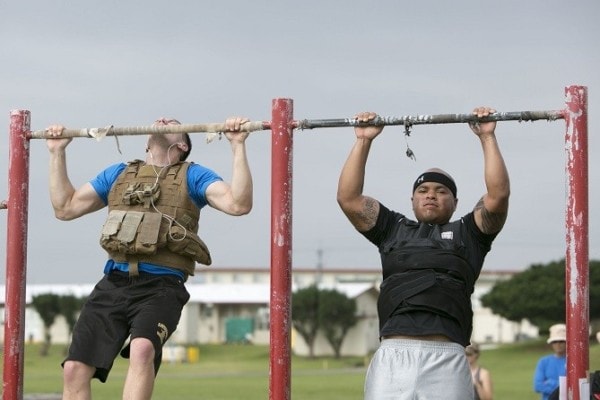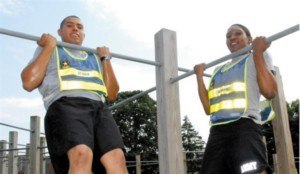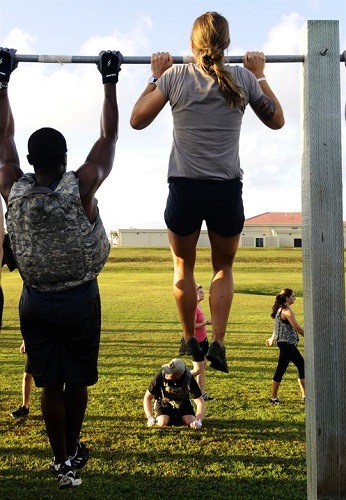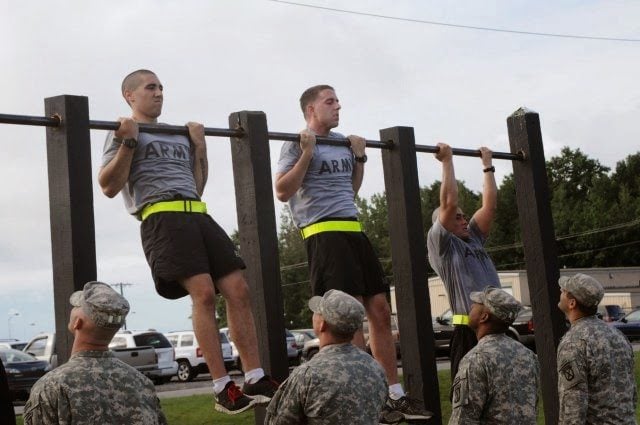Weighted Pull-ups: Benefits, Right Way Of Doing, And Equipment To Use

The weighted pull-ups are a phenomenal exercise that can build muscle mass in your core, back, and arms. Aside from this, it can also strengthen your upper body. Both professional athletes and beginners perform this type of exercise.
Indeed, this variation of pull-ups can increase your maximum performance when you are in the gym. It is an advanced exercise that everyone should perform with caution and progress gradually.
One can add more load in doing the weighted pull-ups in the long run. However, the form, movement, and breathing must be taken into consideration to execute it properly.
In this article, we will discuss what weighted pull-ups are, its benefits, proper execution, variations, and equipment to use.
Contents
Weighted Pull-Ups

Weighted pull-ups is a great addition and routine for those athletes who wish to level up their pull-up training. This exercise can help one increase their strength, improve hand grip, and develop the muscles in the back, arms, and upper body.
The weighted pull-ups are a great complement to bench press. It can increase one’s max pull-up repetitions.
According to Dr. Layne Norton, heavy but low-rep sets of about 1 to 5 reps can activate the various types of muscle fibers in the body, which can soon lead to more significant strength benefits.
If you wish to do lots of pull-ups, for example, 20 to 40 repetitions in a range, increase your max pull-up strength. Putting some weight is invaluable and essential in this exercise.
Meanwhile, the weighted pull-ups are a strenuous type of exercise. Thus, only those who have a necessary foundation of strength can attempt this.
Weighted Pull-ups Recommended To Advanced Athletes
Indeed, the weighted pull-ups are suitable for those with a foundation of strength.
Meanwhile, some coaches recommend athletes to do 12 to 15 standard pull-ups first before switching to weighted pull-ups training.
You must remember not to attempt the weighted pull-ups unless you are ready to develop the optimal pull-up form. If you try it without being in the right style, then you can have a higher chance to wreck yourself.
When you add an extra load to your body, the essential requisites of pull-up exercise becomes crucial to avoid injury and increase strength. Keep your shoulders stabilize and contract your core to protect your spine among other things.
But if you are doing at least 12 to 20 regular pull-ups with great form and you are willing to work gradually and cautiously, then you can start moving forward to weighted pull-ups. Here are the recommended pull-up counts depending on the bodyweight:
| BODYWEIGHT | FAIR | GOOD | EXCELLENT |
| Bantamweight Up to 123 Lbs. |
30 | 45 | 60 |
| Featherweight Up to 132 Lbs. |
25 | 50 | 65 |
| Lightweight Up to 148 Lbs. |
37 | 50 | 75 |
| Middleweight Up to 165 Lbs. |
40 | 60 | 80 |
| Light-heavy Up to 181 Lbs. |
50 | 70 | 90 |
| Middle-heavy Up to 198 Lbs. |
50 | 75 | 100 |
| Heavyweight Unlimited |
60 | 90 | 120 |
Benefits of Weighted Pull Ups

Weighted pull-ups is a good for the body. Thus, here are some of the various benefits of performing the weighted pull-ups:
Overall Muscle Growth
In doing the weighted pull-ups, its primary advantages is it can help one gain their total muscle size and strength.
Unlike the regular pull-up, your arm muscles work harder. Then, it leads to more significant gains versus other variations of pull-ups.
Here are the major muscle groups that the exercise target:
- Latissimus Dorsi- This muscle group in your back is located from the armpit and to the waist. The Latissimus Dorsi also includes the forearms and the triceps.
- Trapezius and Rhomboids- These group of muscles is in the middle portion of the upper back, core, and midsection. When you start training, the muscle fibers break down during stimulation. After taking some rest, you will notice now that your muscles will grow bigger.
Weighted Pull-up Strength Standards
There are no universal standards for performing the weighted pull-ups. However, it is a common practice that trained men should target at least three pull-ups with an additional 45 pounds, while women should aim for 25 pounds of weight.
Meanwhile, Pavel Tsatsouline, a Russian coach, says that an achievable goal is to perform pull-up with 50% of bodyweight weights.
On the other hand, Charles Poliquin states that it is impressive if someone can do three pull-ups with 66% of their bodyweight additional load.
Other fitness trainers say that your pull-up strength should be equivalent to your power in doing bench press. So, if you can do the bench press with 200 pounds of weight, then you must be able to do the same in pull-ups.
How To Do The Weighted Pull-up Workouts
Hang on the bar of your fitness power rack to do the weighted pull-ups. If you don’t have the pull-up bar, you can raise the uprights as high as you can instead. On the other hand, you can also get yourself a doorway pull-up bar.
Here are the five steps on how to do the pull-ups:
- First, grab the bar and grip it about shoulder-width apart. Put your palms down and grasp the bar entirely.
- Bend your knees and raise your feet off the floor. Make sure to hang with your arms straight.
- Pull yourself by pulling your elbows close to you. Make sure you lift your weight off the floor.
- Continue pulling yourself all the way up until your chin pass the bar. Make sure that you don’t do half repetitions.
- Lastly, lower yourself until your arms are relaxed and straight. Repeat the process and pull-up.
Pull up Form

![]()
Indeed, proper form and build will determine your success in performing the pull-ups. If your shoulders are broad, then your grip must be full too, but not too full than the shoulder-width apart.
Each repetition must start with the elbows adequately locked at the bottom while the chin is at the top of the bar.
Also, make sure you perform the exercise in the full range of motion and not in half reps.
Check out these guidelines on how to achieve the proper pull-up form.
Guidelines For Proper Form
Make sure that you do the full grip with your palms facing away. Hold the bar higher and closer to your fingers. Your hands must be shoulder-width apart and be sure that you don’t grip too full.
Keep your shoulders back and do not roll them forward. Also, try not to squeeze your shoulder blades. Meanwhile, keep your elbows at a 45-degree angle just like what you do in an overhead press. Do not flare out your elbows and shrug it towards the ceiling.
Your arms must be straight, and elbows are locked.
Raise your chest up but see to it that it will not touch the bar. Bend your knees, lift your feet off the floor, cross your legs, and squeeze your glutes.
See to it that your head is neutral and always looks forward not on the bar. Don’t reach the bar with your head.
Your back must stay neutral as well, and it has a straight line with knees and shoulders. Also, your lower arch must not over-arch.
Finally, always take a big breath at the bottom of the bar. Hold it when you are on the top and exhale or inhale at the bottom.
Some Of The Best Equipment To Use In Weighted Pull-ups
Weight Vest
This gear is one of the best and all-around tools for low to heavy pull-ups. It distributes the weight evenly way better than other products in the market. It also allows on to perform the exercise with optimal technique. For example, you can use this and be conscious of your proper spinal alignment and core activation.
In choosing a weight vest, make sure that you get those with a high weight capacity because the more weight it can hold, the better. Also, you can also take the loads out and customize it.
Dip Belt Or Weight Belt
The dip belts or weight belts can hold a lot of weight. Thus it is also used in heavy weighted pull-ups. The pressure is according to your center of gravity, and you can change it quickly.
In buying for one, check those that are from high-quality strap material such as the leather.
Backpack
If you don’t have access to dip belt or weight vest, then you can make your own with the use of a pack. Check the old bags that you have in your house and make sure that it is still working.
Fill your bag with water bottles, notebooks, heavy books, towels, or any other stuff to make it heavy.
Make sure that the backpack has a durable strap which you can wrap around your back.
Resistance bands
Resistance bands are also an excellent option for home gym athletes. To use this, just put the resistance bands on the floor, wrap it around your shoulders, and pull yourself up to the bar. The resistance bands will stretch, and it mimics the weight a vest gives on the body.
Dumbbells
If you don’t have anything in the house but dumbbells, then you can use it as well.Put it between your legs and ankles as you pull yourself up the bar.
Note, that the dumbbells are not always the best option and you might drop it on the floor and hurt your feet. Thus, be careful in using this.
There are other ways to do the weighted pull-ups. You can ask a partner to pull your ankles or waist for extra resistance, use a sandbag, or others. Just be creative and be very careful in choosing options.
Tips for Doing The Weighted Pull-ups

Here are some of the tips that you can do to perform the weighted pull-ups so you can gain maximum results and prevent from meeting accidents in the gym or inside your home. Check this out now:
Start With Light Weights
In doing any exercises, always remember to start with very light weights first even if you think that the task and the load are too easy. Next, add 3 to 5 pounds of pressure on your next exercise and this weight is enough for most people.
Make sure that you don’t exceed with any more than 5 pounds in the first few weeks of doing the exercise. Check if your body can adapt to the load you have. Take note that your joints and connective tissues take a long time to recover than your muscles.
Experts advise that beginners must start weighted pull-ups with less than 5 pounds and nine pull-ups per week on three various workouts.
Don’t Forget To Warm Up
Start with a light to moderate bodyweight repetitions as a warm-up before going into the actual exercise. It will enable your body to adjust to the task and lift the heavy load. Then, add 5 to 10 pounds until your body adjusts to your working weight.
Increase Your Weighted Pull-Up And Progress Gradually
Make sure to increase your weighted pull-up gradually. This advice must be followed not only in weighted pull-up but in other exercises that can put resistance on your elbows, shoulders, and wrists.
Listen to your body, go easy on every exercise, and learn to stop when the pull-ups are causing you significant troubles.
Know And Master Your Body Weight

![]()
Another good tip is to master your body weight before doing the weighted pull-up.
Learn how to do the regular pull-up first and master it. Do at least 1 to 2 pull-ups in the start until you learn how to do more.
If you can do 20 and more pull-ups, it is time now to challenge yourself. Do more pull-ups depending your body strength and weight.
You can add weight (like a dumbbell between your feet) and do more reps.
Conclusion
In sum, weighted pull-ups are fantastic for the body. It brings various benefits to the body, and it will increase the size of your arms and back muscles.
Start with the regular pull-ups, build your body, and have a proper form. Learn how to master your weight before you move to weighted pull-ups.
Just like any other advanced exercise, extreme care must be observed in its execution since it involves significant risks. But with proper guidance, weighted pull-ups can increase your total strength of the body.
In the end, it is essential always to seek help from professionals so you will still have a guide in every activity that you do.

